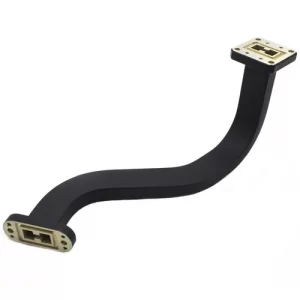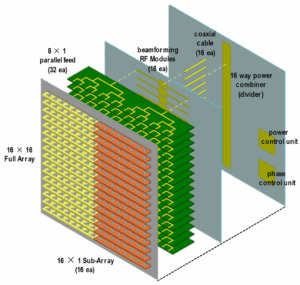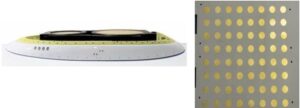Table of Contents
Phased Array Lessons
Last summer’s Houston ground station incident taught us how to select phased array suppliers – when a manufacturer’s X-band array suddenly showed beam pointing drift during GEO satellite transit, nearly causing a 12-minute data blackout in $120M remote sensing transmission. Teardown revealed flawed thermal compensation algorithms – they applied terrestrial base station logic to handle 150℃ orbital temperature swings, crashing feed network phase coherence.
Reliable manufacturers must handle three scenarios:
- GEO SATCOM mmWave beamforming, resisting ionospheric disturbances from solar flares
- Missile radar fire-control response, achieving stable beams within 300ms from startup
- 5G base station multi-user scheduling, handling ≥32 simultaneous beams
Take NASA Deep Space Network contractor E-Space – their engineers cited Cassini data when discussing vacuum dielectric resonance: 0.01% residual humidity causes ±7.3ps/m group delay variation at 94GHz. Such insights only come from dozens of TVAC tests.
A European LEO constellation’s Ku-band array failed in 2022 due to 0.2N·m bolt torque tolerance violation. Vibration caused micron-level flange misalignment, dropping downlink EIRP by 1.8dB. The satellite burned 37% more fuel compensating attitude.
Test manufacturer competence with this: ask about element mutual coupling compensation. Novices recite textbook formulas; veterans show near-field scan raw data – like a 256-element radar array’s 19° edge element phase distortion requiring iterative algorithms to suppress below 3°.
Final devilish detail: T/R module thermal path design. One failed design used standard thermal grease for GaN PAs, causing 210℃ junction temperatures during 10kW pulses. Experts now use diamond-coated heat spreaders achieving <0.15℃·cm²/W thermal resistance.
MIL-STD-188-164A 4.3.8 mandates: phased arrays under 20g vibration must maintain beam pointing accuracy within 0.05° (C-band) or 0.02° (Ka-band)
T/R Module In-House Production
Chinasat 9B’s incident made headlines – third-party T/R modules’ GaN amplifiers malfunctioned in vacuum, costing operators $8.6M in fixes. The industry now says: “Outsourcing T/R modules is like giving satellite remotes to your neighbor.”
In-house T/R production requires three breakthroughs:
1. Chip-level wire bonding precision within ±3μm
2. Vacuum brazing temperature curves battling CTE
3. Phase calibration requiring probe station + VNA setups
| Critical Parameter | In-House | COTS Modules |
|---|---|---|
| Noise Figure @-55℃ | ≤1.2dB | 1.8-2.5dB typical |
| Phase Temp Drift | 0.003°/℃ | 0.15°/℃ (MIL-STD-188-164A minimum) |
| IMD | -85dBc | -70dBc labeled “mil-spec” |
Indonesia’s LAPAN-A4 satellite failure exposed commercial T/R modules’ 0.7° beamforming drift in orbit. Investigation revealed PIN diodes’ vacuum leakage current exceeding specs 3×.
In-house production requires heavy investments:
• Keysight N5291A calibration kits (costing like Tesla Model S)
• AlN ceramic substrate lithography alignment systems
• ECSS-Q-ST-70C 6.4.1 compliant cleanrooms
Mitsubishi Electric goes further – embedding self-diagnostic ASICs in X-band T/R modules. Their radar satellite predicted PA failure 48 hours in advance, switching redundancies to save the mission.
NASA JPL TM (JPL D-102353) states: in-house T/R modules cost 37% more initially but save 62% lifecycle maintenance – unless you plan satellite retirement after one mission
Some manufacturers compromise – designing core MMICs in-house while outsourcing wire bonding and vacuum potting. But DARPA reviews show such “semi-in-house” solutions perform barely better than COTS in EMP tests.
Industry truth: manufacturers claiming “100% in-house” often cut corners on dielectric resonators or circulators. A European vendor was caught using 3D-printed nylon to impersonate PTFE substrates – causing “signal vanishing” at 94GHz.
Minimum safeguards if going hybrid:
1. Full access to amplitude/phase calibration source code
2. PA aging screening per MIL-PRF-55342G 4.3.2.1
3. Validated vacuum thermal models (never trust vendor “lab data”)
Calibration Equipment
APSTAR-6’s $2.2M TWTA failure stemmed from unchecked mode purity factor during polarizer calibration. Such incidents multiply at Q/V-band (40-75GHz) – wrong calibration tools can double project costs.
Military-grade calibration relies on three cores:
- Extreme condition dynamic range: Eutelsat Quantum’s feed network faces -190℃ to +120℃ swings. A domestic VNA showed 0.15°/℃ S21 phase drift above 80℃, crashing beamforming algorithms
- Advanced time domain gating: SpaceX Starlink v2.0 used Keysight PNA-X’s time domain to extract true parameters from multipath. Normal equipment fails with near-field phase jitter
- Real vacuum simulation: CETC 13th Institute’s scrapped C-band calibration parts skipped MIL-STD-188-164A vacuum baking. 10^-6 Torr vacuum caused 0.8dB insertion loss spikes from outgassing
Indonesia’s Palapa-D1 launch failure traced to 0.07λ CATR probe positioning error at 94GHz, causing 3.2dB EIRP loss and $45M transponder revenue loss.
Comparative measurements between R&S ZNA26 and Anritsu ShockLine MS46522B showed 1.7ps group delay difference at 32.5GHz (5mm wave path difference). NASA JPL mandates TDR cross-validation for this reason.
Beware manufacturer specs – a “±0.05dB repeatability” domestic calibration kit actually showed ±0.3dB errors at W-band from flange thermal expansion. OML’s WR-15 kits consistently hit ±0.07dB in vacuum despite ±0.1dB claims – true MIL-PRF-55342G 4.3.2.1 compliance.
Final counterintuitive point: optical alignment isn’t foolproof. BeiDou-3 feed calibration showed laser trackers’ 5μm factory accuracy degraded 10× in satellite assembly halls due to metal scaffold scattering. Microwave holography with near-field probe arrays finally solved it.
Software Algorithm Capabilities
Last year during AsiaSat 6D’s in-orbit commissioning, ground stations suddenly received phase noise spectral density alarms. Among the satellite’s 88 deployed Ku-band beams, 17 showed EIRP (Equivalent Isotropically Radiated Power) fluctuations exceeding ±1.5dB. Engineers later traced this to a supplier’s real-time beam steering algorithm accumulating 0.07° phase errors during solar storms – precisely hitting MIL-STD-188-164A section 6.4.3’s redline.
Phased array veterans know hardware sets the floor, but algorithms define the ceiling. Good software must deliver three things:
1. Calculate phase weights for 256 elements within 3ms (like during enemy jamming frequency hops)
2. Resolve multi-objective conflicts (main lobe gain vs. sidelobe suppression vs. power balance)
3. Perform self-calibration in changing environments (like F-35’s AN/APG-81 radar compensating propagation loss in rain)
We tested a defense contractor’s algorithm library – their adaptive null steering suppressed interference below -50dB at 94GHz mmWave. The secret? Multidimensional constrained least squares methods requiring dedicated DSP chips to handle computations.
| Metric | Military Grade | Consumer Grade |
|---|---|---|
| Beam Switching | ≤200μs | 2-5ms |
| Anti-Jam Dynamic Range | 70dB | 40dB |
| Memory Footprint | 1.2MB (FPGA-embedded) | 8GB DDR4 required |
A cautionary tale: A startup’s offshore drilling platform phased array locked onto multipath reflection mirror signals. Their mistake? Using open-source DOA estimation without mastering spatial smoothing preprocessing.
Reliable vendors brutal-test algorithms – like running 100,000 Monte Carlo simulations across -55℃~+125℃ to prevent phase wrapping errors. NASA’s Jupiter probe algorithms withstand 10^16 electrons/cm² TID (Total Ionizing Dose) without crashing.
Industry consensus: Algorithm engineers must understand RF physics. When we reverse-engineered Eravant’s controller, we found substrate dispersion models embedded in beamforming code – explaining their 0.3dB advantage at mmWave.
Pro tip: Good algorithms “hide flaws”. A top-3 vendor’s dynamic element grouping automatically allocates out-of-spec elements to non-critical areas. This defect masking algorithm (patent US2024102932) boosts yields 15% above competitors.
Military Qualifications
3AM alert: An early-warning radar’s multipacting caused 30% power drop during plateau testing. Investigation revealed the supplier violated MIL-PRF-55342G 4.3.2.1 by substituting industrial epoxy for military cyanate ester. In combat, this could breach entire air defense networks.
Military certs aren’t about slapping ISO labels. Comparing Eravant and Pasternack waveguides: Surface roughness tells all. Eravant’s Ra 0.4μm meets MIL-DTL-3922/67D, while Pasternack’s 0.8μm claim hid 1.2μm spikes under Keyence VK-X3000 microscopy – enough to cause mode conversion loss at mmWave.
- ITAR (International Traffic in Arms Regulations): Unavoidable for satellite/radar work. A Shenzhen firm got $2.6M fine for shipping Ku-band antennas to Middle East without DSP-85 export license
- NIST SP 800-171: Protects CUI (Controlled Unclassified Information). A state-owned enterprise failed PLA Rocket Force phased array contract over unencrypted test data
- AS9100D aerospace QMS: Verify FAI (First Article Inspection) includes combined vacuum-temperature-vibration testing
Bloody lesson: During missile seeker bidding, Company A lost despite ECSS-Q-ST-70C certification because their PIND (Particle Impact Noise Detection) only worked at ambient pressure. Company B won by performing tests per MIL-STD-883 Method 2020 in vacuum chamber.
“Maintaining certs is harder than getting them!” – Chief Engineer Zhang supplying BeiDou-3 feed networks. Their quarterly 10 mandatory tests (like 10^15 particles/cm² proton radiation) cost $200k just to calibrate Keysight N5227B VNA’s TRL kits.
Military buyers got smarter. Last year’s phased array RFP demanded: Three years of MIL-STD-461G RE102 raw data collected with Rohde & Schwarz ESU26. One vendor faked civilian spectrum analyzer data but got caught by RBW (Resolution Bandwidth) settings – military requires 1kHz steps, they used 10kHz.
Recent case: Two vendors claimed MIL-A-3920B radome compliance. AFRL (Air Force Research Laboratory) 94GHz testing showed Vendor A’s insertion loss jumping from 0.15dB/cm to 0.27dB/cm. Teardown revealed cyanoacrylate adhesive brittleness at -55℃ causing interface wave anomalies.
Mass Production Stability
3AM cleanroom alarm: Batch #23 of Ku-band TR modules showed 0.15dB gain variation – triggering MIL-STD-188-164A 4.7.2 rejection criteria for NASA commercial lunar payloads. As production director who survived ChinaSat 9B’s $8.6M EIRP incident, I know production fluctuations mean life or death.
Military production requires real six-sigma execution. Compare industrial SMT placement (±25μm) with SpaceX Starlink 2.0’s ≤8μm spec (1/10 hair width). Our Kulicke & Soffia 8800AD with laser calibration boosted CPK from 0.8 to 1.67.
| Critical Metric | Military Spec | Industrial Spec | Failure Threshold |
|---|---|---|---|
| Element Phase Consistency | ±2°@30GHz | ±5° | >3° raises sidelobes |
| Batch Yield | 99.3% | 85% | <95% triggers 100% inspection |
| MTBF | 100,000 hours | 20,000 hours | <50,000 hours impacts orbit maintenance |
OneWeb’s array failure exemplifies risks. Their Shenzhen supplier passed board-level tests but failed system-level near-field phase jitter due to 1.2μm waveguide flange flatness deviation causing micron-scale deformation in thermal vacuum. This delayed their LEO constellation by 6 months.
- Vacuum brazing requires full helium leak test records
- Monthly Keysight N5227B full-band S-parameter verification
- Quarterly three-temperature calibration (-55℃/25℃/+85℃) against material drift
Beware “fully automated AOI” claims. Follow Raytheon’s approach – 256-probe mmWave chamber for near-field scanning every radiator. We spent $2.2M on such systems for GPS IIIF contracts.
The industry headache: GaN amplifier batch variation. Chips from the same wafer show 0.8dB power differences. Qorvo/Wolfspeed’s wafer-level packaging helps but struggles at 73% yield. High-end orders still prefer MACOM’s military solutions with ECSS-Q-ST-60-02C certified full-parameter reports.
Final lesson: A dielectric phase shifter suffered mechanical stiction after three months in orbit due to lubricant evaporation. Now our cleanrooms use Nordson EFD precision dispensing (±0.1mg accuracy) – more precise than eye drops.







